

Cultural Protocols University Council%20(Final) Aboriginal Languages - Australian Indigenous Language (verbal, non verbal) When I speak language, it makes me feel [at] home.
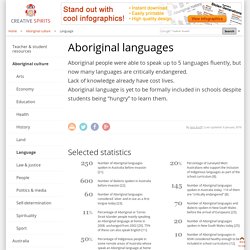
—Roger Hart, Aboriginal elder [1] I think that Australia holds one of the world's records for linguicide, for the killing of language. —Prof Ghil'ad Zuckermann, linguist, Adelaide University [2] Multilingual memory masters Aboriginal people are experts when it comes to language. In my community, it was common to speak 10 languages.
“[Aboriginal] language is an important embodiment of cultural heritage, knowledge, tradition and identity unique to Aboriginal and Torres Strait Islander peoples,” says Russell Taylor, Principal of the Australian Institute of Aboriginal and Torres Strait Islander Studies (AIATSIS) [3]. Languages don’t just carry information. For Aboriginal Senior Australian of the Year and Yolngu Elder Laurie Baymarrwangga language carries the essence of Aboriginal culture. Aboriginal people “often don’t even know that [their mother] language is still strong and people speak it. Aboriginal language groups Mourning. Teacher and student resources on multiculturalism, cultural diversity and tolerance.
Jessica Mauboy to kick off Australia Day celebrations by singing the national anthem in Aboriginal languages. Uncle Max Eulo conducts a smoking ceremony during the official announcement of the Australia Day 2016 program.
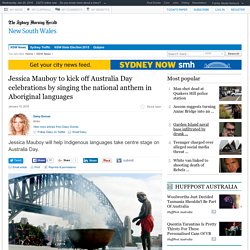
Photo: Steven Siewert Jessica Mauboy will help to unfurl celebrations across Sydney on Australia Day by singing the national anthem in local Indigenous languages while perched on top of the Sydney Harbour Bridge. The breakfast-time performance by the 26-year-old Aboriginal star is part of the day's WugulOra ceremony, one element in a powerful display of First Nations tradition on a date that will forever be "complex" for Aboriginal and Torres Strait Islanders. For the first time, smoking ceremonies - cleansing rituals that are millenniums old - will take place at seven points around the harbour in remembrance of the founding of New South Wales in 1788. Max "Dulamunmun" Harrison III and Dwayne "Naja" Bannon-Harrison during the smoking ceremony. Aboriginal elder Uncle Max Eulo, who will lead one of the ceremonies, said the day is more about history than celebration.
The Dreaming. Aboriginal dancers telling Dreamtime stories at the Sydney Olympics opening ceremony.
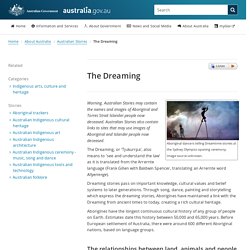
Image source unknown. Warning. Australian Stories may contain the names and images of Aboriginal and Torres Strait Islander people now deceased. Australian Stories also contain links to sites that may use images of Aboriginal and Islander people now deceased. The Dreaming, or 'Tjukurrpa', also means to 'see and understand the law' as it is translated from the Arrernte language (Frank Gillen with Baldwin Spencer, translating an Arrernte word Altyerrenge). Dreaming stories pass on important knowledge, cultural values and belief systems to later generations. History ‐ Australia Day. What drew Australians together in this way?
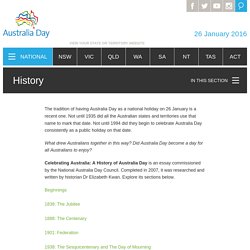
Did Australia Day become a day for all Australians to enjoy? Celebrating Australia: A History of Australia Day is an essay commissioned by the National Australia Day Council. Completed in 2007, it was researched and written by historian Dr Elizabeth Kwan. Explore its sections below. 1938: The Sesquicentenary and The Day of Mourning ‐ Australia Day. By 1938 Australians, still 98 per cent British in background, had, after almost one hundred years, found agreement on the name, timing and nature of the day's celebration they had come to share.
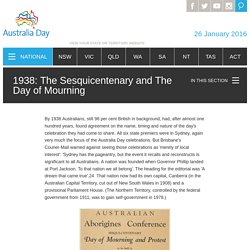
All six state premiers were in Sydney, again very much the focus of the Australia Day celebrations. But Brisbane's Courier-Mail warned against seeing those celebrations as 'merely of local interest': 'Sydney has the pageantry, but the event it recalls and reconstructs is significant to all Australians. A nation was founded when Governor Phillip landed at Port Jackson. To that nation we all belong'. The heading for the editorial was 'A dream that came true'.24 That nation now had its own capital, Canberra (in the Australian Capital Territory, cut out of New South Wales in 1908) and a provisional Parliament House. FIGURE 16: The flyer, with resolution, advertising Australian Aborigines' Conference and Sesquicentenary Day of Mourning and Protest, 26 January 1938. Education Resources ‐ Australia Day.
NADC Education Resources The National Australia Day Council (NADC) has developed the following education resources to support and promote active citizenship with young Australians.
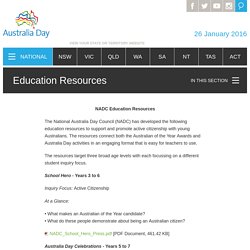
The resources connect both the Australian of the Year Awards and Australia Day activities in an engaging format that is easy for teachers to use. The resources target three broad age levels with each focussing on a different student inquiry focus. School Hero - Years 3 to 6 Inquiry Focus: Active Citizenship At a Glance: • What makes an Australian of the Year candidate? NADC_School_Hero_Press.pdf [PDF Document, 461.42 KB] Australia Day Celebrations - Years 5 to 7 Inquiry Focus: National Identity What do Australia Day celebrations, Citizenship Ceremonies and pledges and the Australian of the Year Awards tell us aboutour sense of ourselves as Australians?
NADC_Australia_Day_Celebrations_Press.pdf [PDF Document, 407.19 KB] Trueblue activitysheets march.